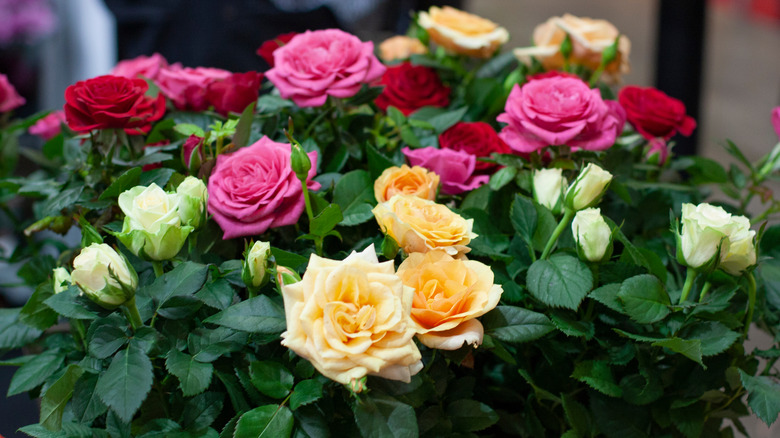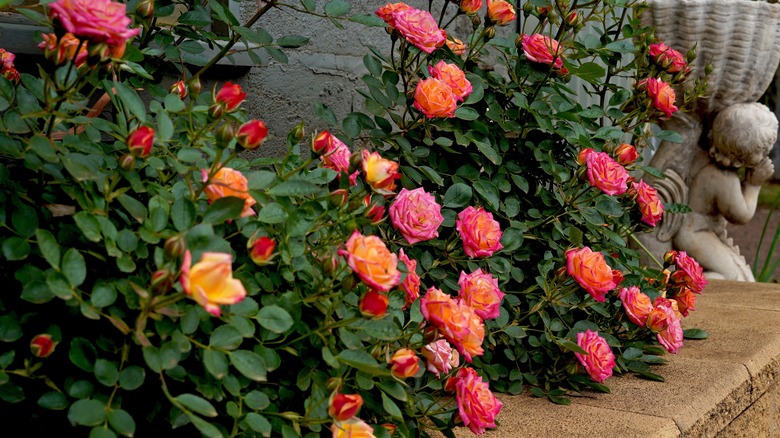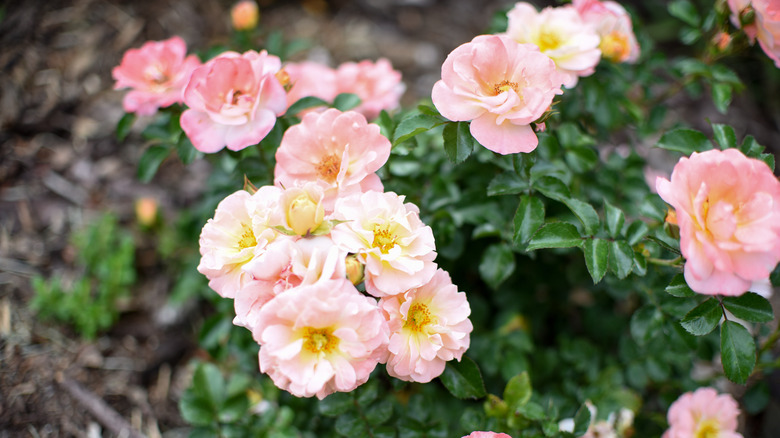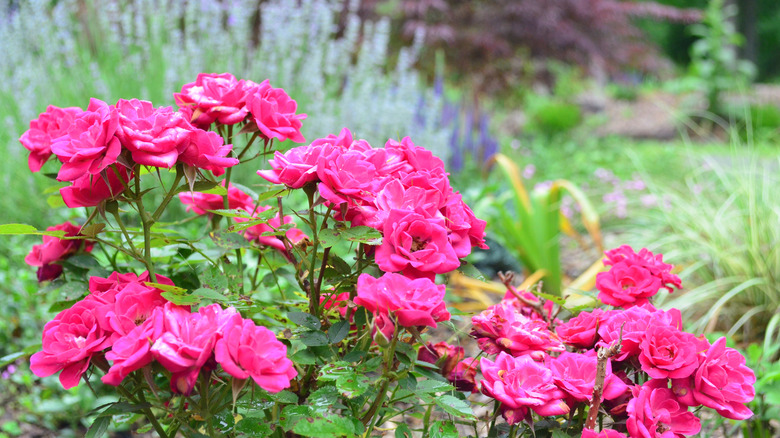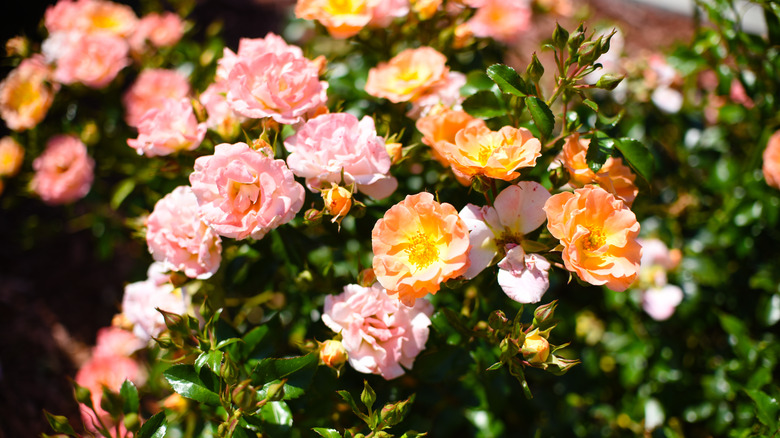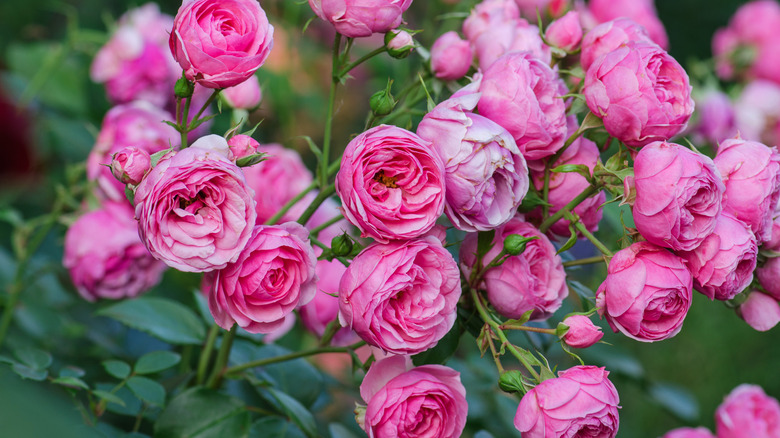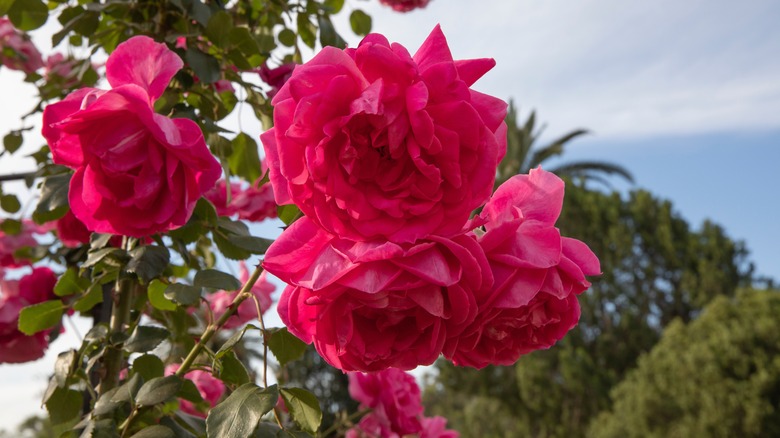Miniature Roses: Everything You Need To Know Before Planting
Miniature roses aren't a specific genus or species of rose. Rather, the term refers to the size and cultivar of the rose, which is, as the name would suggest, much smaller than the typical rose. More than that, miniature roses are bred to be hardy, thornless, disease tolerant, and more likely to continually bloom than other cultivars, according to Minneopa Orchards.
The first miniature rose cultivar is believed to date back to the 1700s in China, which was then sold in European and Asian markets. Named cultivars have various invention dates, some as far back as the early 19th century, and some classic ones at the turn of the 20th. Miniature roses tend to grow anywhere from 1 to 3 feet tall and roughly 2 feet wide, and grow in clusters of small, tiny flowers — somewhat resembling hybrid tea roses. Miniature roses can also be grown indoors as a unique houseplant.
How to use in garden
Since there are so many varieties and cultivars of miniature roses, there are various growing conditions and uses for your garden. That being said, HGTV says they are averagely hardy in USDA hardiness zones 5 through 9. If you're in a cooler or hotter climate, check for specific cultivars in your zone. As for using the roses in your landscaping, there are quite a few options. The bushes themselves tend to be more compact, and not nearly as tall as some other, more dramatic rose bushes. This gives miniature roses a more delicate and dainty look.
Bloom IQ recommends planting miniature roses with taller flowers such as dahlias, irises, and gladiolas, planting the roses in front to mix heights and feature the roses more prominently. Miniature roses can also look really unique amongst ground cover plants since they won't be much larger, but tall enough to add texture and visual diversity. Those looking to keep pests away and pollinators near should plant them with lavender, salvia, and thyme.
How to grow miniature roses
The easiest way to grow a gorgeous and healthy miniature rose bush is to visit your local garden center or nursery during the late spring or early summer and choose from the available cultivars. Plant the bush in the ground following the center's instructions. However, if you have a healthy and mature plant you want to replicate, you can regrow additional roses via propagation.
Begin by looking for a mature rose, preferably in the early spring when the buds aren't full yet, explains Turf Explorer. Use clean, sharp gardening or rose pruning shears to cut the rose off about 6 inches from the first leaf. Strip the rest of the leaves, and dip the raw bottom into rooting powder. Prepare a pot with either potting soil or perlite, and add your cutting. Keep the cutting in indirect sunlight and consistently moist until the flower cutting has rooted. To test that it's rooted, gently tug on the cutting — if it resists, there are roots. This should take anywhere from four to six weeks. Once rooted, you can leave it in the pot or transfer it into your garden.
How to care for miniature roses
Caring for miniature roses is a very similar process to caring for any rose. Dedicated rose gardeners tend to have their own specific quirks when it comes to caring for the flower, but in general, they only need to have a few specific needs met. To begin, miniature roses need lots of sunlight. Masterclass recommends six to eight hours of full sun a day. While it is also possible to plant them in afternoon shaded areas, their blooms won't be as full or vibrant.
In-ground miniature roses should have a well-draining, loamy, but light soil mixture. Consider adding peat moss for richness as well as root support. Roses like to be kept moist, but not soggy, so avoid overwatering and consider using a moisture meter if you notice signs of root rot. Miniature roses have the potential to continually bloom throughout the season, which can be encouraged in a number of ways. One is by fertilizing your roses once a month, beginning after the last threat of frost in spring and ending before the first frost in fall, using a rose or blooming specific fertilizer. Roses should also be pruned once a year before the first frost, but more importantly, they should be deadheaded weekly. This will help them redirect energy towards producing new flowers as opposed to trying to revive the dead ones.
Miniature rose varieties
Miniature roses aren't one specific type of rose, but rather refer to a wide array of multiple cultivars of smaller, compact roses. There are plenty of varieties to choose from, which offer different sizes, colors, and hardiness zones. Here are just a few from John Denson's World of Gardens:
-
Coffee bean — this miniature rose cultivar bears a striking resemblance to the hot cocoa variety of floribunda roses and has dark orange-red petals. It grows up to 1.5 feet tall and thrives in USDA hardiness zone 6.
-
Cupid's kisses — this climbing variety has dark pink petals with bright yellow centers, and can climb 4 feet tall and spread up to 3 feet wide, growing best in hardiness zone 5.
-
Jilly jewel — this cultivar is very small, the delicate soft pink flowers only growing two inches across, while the plant itself grows 24 inches tall at most. It grows best in zone 5.
-
Sun sprinkles — this yellow variety has double flowers similar to the knock out cultivar and has a very strong sweet and spicy fragrance. They grow best in zones 6 through 10.
-
Liberty bell — This cultivar looks like a miniature version of the Mr. Lincoln hybrid tea rose, the flower blooms in a deep red color and grows best in hardiness zone 5.
Are miniature roses toxic?
Whether you're planning on growing your miniature roses as an indoor houseplant or an outdoor in-ground or container flower, you should know if it's poisonous for both humans and animals. Luckily, all members of the rose family are considered non-toxic to cats, dogs, and horses, according to the ASPCA.
As for humans, roses are not only non-toxic but edible. Roses contain vitamins A and C, as well as iron, calcium, potassium, phosphorus, and a host of other beneficial properties, notes Plant Addicts. Many cuisines feature roses, whether by adding rose water to various desserts, drinking rose-flavored drinks, using roses in herbal medicinal, or simply as edible decorations. Yellow, pink, and white roses tend to be the most potent and flavorful for eating. Just because roses themselves are edible, though, doesn't mean the chemicals treating them are. If you aren't chemically treating your roses, they're generally safe to eat, however, store-bought roses are often treated with harmful pesticides.
How to repot miniature roses
Miniature roses are unique, not just in terms of size, but also in that they can be grown indoors as a houseplant. They are also commonly grown outdoors in containers as opposed to in the ground, used to decorate patios and porches. Wherever you're growing your roses, if they're in a container, they'll need to be repotted periodically. This is beneficial for a couple of reasons. The roots may be outgrowing the current pot size, or after a while, the rose bush will use up all of the soil's nutrients. Plan to repot every two to three years.
Masterclass says that you need a pot that is slightly bigger than the plant and has excellent drainage holes. Unpot your current rose bush by tipping it on its side and gently sliding it out. Then, prepare the new pot with a rose-specific soil mixture. Create a hole in the soil that is a couple of inches wider than the rose bush's total width, and add the root ball to the hole. Fill the rest of the way with soil, and water to expose air pockets. Fill the air pockets with soil, and then mulch the top (keeping it a few inches from the crown), to help the plant both self-regulate its moisture levels as well as protect its roots.
